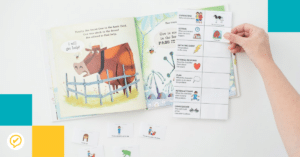We shared a review of articulation approaches, and now we’re diving into a case study for the Cycles Approach.
Why the Cycles Approach?
ASHA summarized a systematic review of the Cycles Approach by Hassink & Wendt (2010).
Here’s a snippet of what they had to say:
“Although evidence was limited, several studies indicated that ‘it is plausible that the Cycles Approach results in improved consonant production in conversational contexts …, that children with less severe phonological and language impairments improve in both domains when the Cycles Approach is used …, and that earlier implementation of the Cycles Approach results in improved outcome’ (Suggestive Evidence; p. 4).”
Check out the full review (it’s free!) for a closer look.
A Case Study for the Cycles Approach
Jayden is a four-year-old preschooler.
He consistently uses the following sounds: bilabials /p, b, m, w/, alveolars /t, d, n, l/, palatal /j/, glottals /h, ʔ/. He was stimulable for /f, v, s, k/ when significant verbal and visual cues were provided. Phonemes /g, ŋ, z, ʃ, t͡ʃ, d͡ʒ, ð, θ/ were not stimulable.
Evaluation results reveal a phonological disorder characterized by cluster reduction (90% of opportunities), fronting (100% of opportunities), and stopping (100% of opportunities).
Jayden’s speech is very difficult to understand. His parents say they understand about 70% of what he says; Jayden’s teacher understands about 50% of his speech.
His teacher reports that Jayden gets frustrated easily and tends to get distracted after about 3 minutes of work.
Sample Target Selection for the Cycles Approach
We started our first cycle with cluster reduction (/sp-/, /st-/, /-ts/, /-ps/) and fronting (final /k/, initial /k/).
If you’re wondering how to select your own targets and structure your therapy sessions, this blog post by Banter Speech is super helpful! Playing with Words 365 also has a planning sheet that can help you organize your therapy steps.
Sample Goals for the Cycles Approach
Example Long-Term Goal
Jayden will increase his intelligibility by independently producing /s/-clusters (/sp-/, /st-/, /-ts/, /-ps/) and velars (/k/, /g/) in sentences during structured language activities with 80% accuracy by ____.
Example Short-Term Goal
Jayden will independently produce /k/ in words with 80% accuracy during structured language activities by ____.
• Provide verbal and visual cues as needed, explaining and demonstrating placement
• Baseline Data: Jayden is stimulable for /k/ in single CVC words with 60% accuracy all positions. This data was collected when a new level of target was introduced.
• Carry-Over Probes: Probes after each 2-3 week cycle before moving on to the next level (e.g., phrase, sentence, etc.)
Sample Activities for the Cycles Approach
Literacy-Based Activities to Target /k/
1. If You Give a Cat a Cupcake by Laura Numeroff
2. Caps for Sale by Esphyr Slobodkina
3. Cupcake by Charise Mericle Harper
Drill-Based Activities
Shannon from Speechy Musings also makes a fabulous toolkit that helps break down the process.
If you’re an SLP Now member, I love using the SLP Now Articulation Stickers and Phonology Sheets! See them in action here.
Race to Color: I print a sheet of paper with 30-50 figures (e.g., super heroes, robots, vehicles, animals). Students are able to color a figure after each target is said accurately 2-4 times. The goal is to get at least 100 trials. The student is able to pick a reward (e.g., a sticker) after the sheet is fully colored.
Beat the Timer: The student practices saying target word as many times as he/she can before the sand timer runs out. Students can “compete” to see if they can beat their past scores.






Thanks for breaking down the Cycles approach! Barbara Hodson has an article that I found helpful for explaining the principles behind the approach to help us understand why the approach is structured as it is. https://leader.pubs.asha.org/doi/10.1044/leader.FTR2.16042011.16
Also, may I suggest that goals for phonological delays should be written with the pattern to be addressed in mind? (E.g. “Client will eliminate the phonological pattern of fronting in conversational speech by accurately producing /k/ and/g/ with 80% accuracy.”)
Thank you for publishing this series of blog posts on approaches to remediating speech sound disorders!
Yes! Thanks for adding that article!
Also appreciate the goal suggestions!